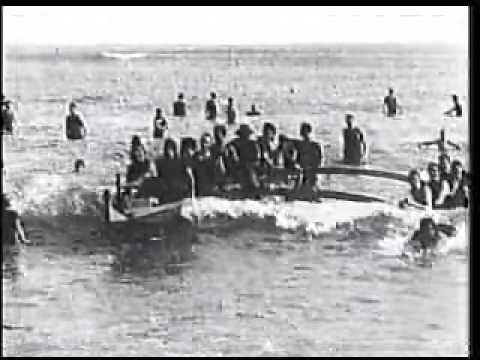The art of surfing, known as he’enalu in the Hawaiian language, was first described in 1769 by Joseph Banks on the HMS Endeavour during the third voyage of Captain James Cook. Surfing was a central part of ancient Polynesian culture and predates European contact. The chief (Ali’i) was the most skilled wave rider in the community with the best board made from the best tree. The ruling class had the best beaches and the best boards, and the commoners were not allowed on the same beaches, but they could gain prestige by their ability to ride the surf on their ratchet boards.
The video below is considered to be the oldest surviving surf footage shot in 1906 by Thomas Edison during his vacation in Waikiki.

For centuries, surfing was a central part of ancient Polynesian culture. Surfing may have first been observed by Europeans at Tahiti in 1767 by Samuel Wallis and the crew members of the Dolphin who were the first Europeans to visit the island in June of that year. Another candidate is the botanist Joseph Banks being part of the first voyage of James Cook on the HMS Endeavour, who arrived on Tahiti on 10 April 1769. Lieutenant James King was the first person to write about the art of surfing on Hawaii when he was completing the journals of Captain James Cook upon Cook’s death in 1779.
When Mark Twain visited Hawaii in 1866 he wrote,
In one place we came upon a large company of naked natives, of both sexes and all ages, amusing themselves with the national pastime of surf-bathing.
References to surf riding on planks and single canoe hulls are also verified for pre-contact Samoa, where surfing was called fa’ase’e or se’egalu (see Augustin Krämer, The Samoa Islands), and Tonga, far pre-dating the practice of surfing by Hawaiians and eastern Polynesians by over a thousand years.
In July 1885, three teenage Hawaiian princes took a break from their boarding school, St. Mathew’s Hall in San Mateo, and came to cool off in Santa Cruz, California. There, David Kawananakoa, Edward Keliiahonui and Jonah Kuhio Kalaniana’ole surfed the mouth of the San Lorenzo River on custom-shaped redwood boards, according to surf historians Kim Stoner and Geoff Dunn.
George Freeth (8 November 1883 – 7 April 1919) is often credited as being the “Father of Modern Surfing”. He is thought to have been the first modern surfer.
In 1907, the eclectic interests of the land baron Henry Huntington brought the ancient art of surfing to the California coast. While on vacation, Huntington had seen Hawaiian boys surfing the island waves. Looking for a way to entice visitors to the area of Redondo Beach, where he had heavily invested in real estate, he hired a young Hawaiian to ride surfboards. George Freeth decided to revive the art of surfing, but had little success with the huge 16-foot hardwood boards that were popular at that time. When he cut them in half to make them more manageable, he created the original “Long board”, which made him the talk of the islands. To the delight of visitors, Freeth exhibited his surfing skills twice a day in front of the Hotel Redondo.
